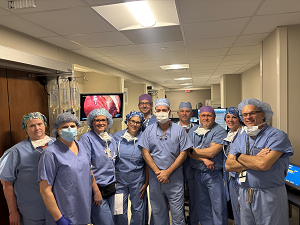MKTP Surgery Has Long-Term Benefit for Restoring Skin Pigmentation in Vitiligo Patients
DETROIT – A Henry Ford Hospital study has shown that skin transplant surgery has long-term benefit for restoring skin pigmentation caused by the skin disease vitiligo.
In a retrospective study, researchers found that a majority of areas of the skin treated with surgery still had “very good to excellent” color match pigmentation five years later.
Treated areas included the face, neck, hands, torso, legs and feet. Skin type, age and location of the vitiligo had no significant effect on the outcome of the repigmentation.
The surgery is known as melanocyte-keratinocyte transplantation or MKTP. During surgery, melanocyte skin cells responsible for giving color to the skin, hair and eyes are harvested from healthy, pigmented areas of the body and transferred to an area that lost its pigment. Pigmentation starts to return to the surgery area in about two months.
The study is published in the Journal of the American Academy of Dermatology.
“MKTP works and it lasts a long time,” says Iltefat Hamzavi, M.D., a Henry Ford dermatologist and the study’s senior author and principal investigator. “It’s better than any technology we have to treat this condition.”
Vitiligo develops when melanocyte cells are killed by the body’s immune system, causing the area of the skin to turn white because the cells no longer make pigment. The white lesions vary in size and location – face, hands, arms, feet and torso. It is more noticeable in people with darker skin.
The American Academy of Dermatology says millions of people are living with vitiligo worldwide.
Vitiligo has two types – segmental and nonsegmental. Segmental vitiligo appears on one segment, or part, of the body like the face or arm. Nonsegmental vitiligo is the most common type and appears on both sides of the body such as the hands and knees.
The skin disease is non-contagious and treatable – topical medication, light therapy, depigmentation and skin grafting, among them. However, it’s emotionally stigmatizing for those living with it and often comes with awkward stares and impolite comments.
Henry Ford’s study is believed to be the first in the United States to evaluate MKTP’s long-term benefit. Researchers analyzed repigmentation results in 63 vitiligo patients who underwent MKTP between January 2009 and April 2014. Key highlights:
- 71 percent repigmentation was maintained in 45 segmental vitiligo lesions five years after surgery.
- 64 percent repigmentation was maintained in 90 nonsegmental vitiligo lesions five years after surgery.
- 75 percent repigmentation was maintained in all vitiligo lesions at two, four and five years after surgery.
In 2009 Henry Ford became the first hospital in North America to perform MKTP. Its benchmark research published in the Archives of Dermatology found that MKTP was safe and effective for treating vitiligo, for which there is no cure. It also demonstrated the potential for restoring pigmentation – in eight patients with a specific type of vitiligo, the treated area regained on average 74 percent of its natural skin color after six months.
“We were the first North America center to show it works. Now we can show that not only does it work, it lasts for years in a majority of patients,” Dr. Hamzavi says.
Since the early years, Dr. Hamzavi and his team have refined MKTP’s technique to maximize the potential for repigmentation. Most notable is that a laser is now used for removing the white vitiligo lesions and prepping it to receive the healthy melanocyte cells. Previously, doctors used a dermabrader. Also, more superior dressings bring improved comfort to patients.
“If you pick the right patient, do the procedure properly – the majority of patients will maintain their color,” Dr. Hamzavi says of MKTP.
The study was funded by Henry Ford’s Department of Dermatology.
###
MEDIA CONTACT: David Olejarz
313.874.4094
.svg?iar=0&hash=F6049510E33E4E6D8196C26CCC0A64A4)

/hfh-logo-main--white.svg?iar=0&hash=ED491CBFADFB7670FAE94559C98D7798)









